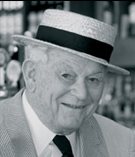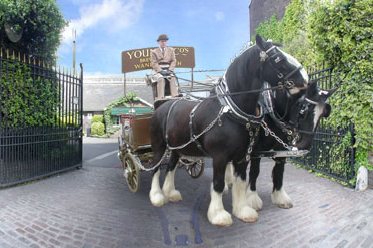 |
 |
|

|
|

|
 |
home
about
Protz
features
A-Z
books
|
|
Protz:
features
reviews
tastings
news & events
books
|

| |
John Young, RIP
by Willard Clarke , 10/2006
John Young will have a prominent place reserved in the Brewers' Hall of Fame, revered as the father of the "real ale revolution", an iconoclast who believed in good traditional beer drunk in good traditional pubs. Young, chairman of Young's of Wandsworth in south London for 44 years, who has died aged 85, steered the family brewery on a different course to the rest of the industry in the 1970s. It was a course that was derided at the time but which proved not only successful for Young's but also encouraged other regional brewers to follow suit.
|
|

|
A spate of mergers in the 1960s had created six national brewers who attempted to transform the way beer was made by switching from cask ale to keg beer - filtered, pasteurised and artificially carbonated.
Panic ensued as such brands as Watney's Red Barrel, Worthington E and Whitbread Tankard rapidly dominated the market. Smaller regional brewers rushed to emulate the 'Big Six', as they were known.

|
|
In Wandsworth, John Young raised his standard above the Ram Brewery, on the oldest brewing site in Britain, and declared he would remain faithful to beer that matured naturally in its cask. He was laughed to
scorn by directors of other breweries. Among the legion of stories about him, one is told of a meeting of the Brewers' Society in London where,
|
during a break for coffee, one member saw a funeral hearse passing by
outside. "There goes anotherof your customers, John," he told Young, to roars of laughter from his colleagues. Above, the modern day brewery.
John Young had the last laugh. He was born in Winchester in 1921, the eldest of four sons of William Allen Young. The family was steeped in brewing. John was the great-great-grandson of Charles Allen Young, one of two businessmen who took over the 16th-century Ram Brewery in 1831. John's mother was Joan Barrow Simonds, a member of the family that owned Simonds Brewery in Reading.
But John's first love was sailing: he was educated at the Nautical College in Pangbourne. Sailing holidays in the late 1930s on the River Orwell in Suffolk brought John and his brothers into contact with Arthur Ransome at Pin Mill, the setting for We Didn't Mean to Go To Sea. Ransome claimed that he, rather than the brothers' father, introduced the boys to the pleasures of beer and darts.
Either side of World War Two, John Young went to Corpus Christi College in Cambridge, where he graduated with an honours degree in economics. During the war he served with distinction as a fighter pilot on aircraft carriers. He left the Fleet Air Arm as a lieutenant commander in 1947 and launched a career in shipping. He was based in Antwerp for a while, where he met his Belgian wife Yvonne. They married in 1951 and settled in West Sussex, from where John, with his brothers, was summoned to work at the Ram Brewery in 1954.
He succeeded his father in 1962 and set about refashioning the company to meet the challenges of the time. Improving the pub estate and offering - a daring move at the time - children's rooms did not mean a move away from traditional values. The brewery retained a fierce commitment to cask beer and delivered it to local pubs by horse-drawn drays, while a live ram mascot, along with ducks and geese, were familiar if bizarre sights at Wandsworth.
|
|

|
The energetic new chairman visited every pub in his estate. He was on first name terms with his landlords and became friendly with regular customers. Company AGMs became lavish affairs where a white suited John Young would proclaim his belief in traditional brewing values. He was so horrified by the way some London pubs were being remodelled in the 1970s as Wild West Saloons or Sputniks that he once threatened to enter one pub armed with a packet of soap flakes to throw into a large fountain that had been installed there.
The commitment to cask beer paid off. Sales of Young's ales rocketed and their success was instrumental in helping the Campaign for Real Ale to make its mark in the early 1970s. In 1975 he was made a CBE to mark his work in brewing and in charity: he was chairman of the National Hospital for Nervous Diseases in Bloomsbury and raised millions of pounds to build new wards and install modern equipment.
His passion for brewing was unabated. Yvonne Young died in 2002 but John continued to work and chair company AGMs, often wielding boxing gloves to see off critics of his policies. In spite of a long battle with cancer, he conducted the 2006 annual meeting, though he was visibly ill. His last few months in office were dogged by controversy: a redevelopment scheme in Wandsworth meant the brewery had to close. When a suitable alternative site could not be found in London, Young's agreed to merge its brewing operations with Charles Wells of Bedford, a move that has not pleased all lovers of Young's distinctive beers.
|
|

|
But 200 Young's pubs will remain in London and the South-east, bricks and mortar reminders of the man who guided their fortunes with undiminished fervour for more than 40 years.
John Allen Young, born 7 August 1921, died 17 September 2006. He leaves a son, James, who is deputy chairman of Young's, and a daughter, Ilse.
|
|
home
about
Protz
features
A-Z
books
|